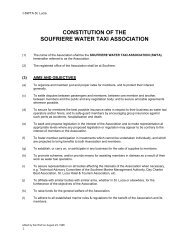WWF Cover photo - Soufriere Marine Management Association ...
WWF Cover photo - Soufriere Marine Management Association ...
WWF Cover photo - Soufriere Marine Management Association ...
Create successful ePaper yourself
Turn your PDF publications into a flip-book with our unique Google optimized e-Paper software.
eserve in the form of increased catches (Goñi et al. 2001b). Goñi et al. (2001a) reported much variation inabundance of lobster, and noted the possible seasonal movement of the lobster to deeper water. Tagging studiesof lobster in the reserve suggest that it is contributing to fishery yields through the seasonal movement of adultsto adjacent unprotected areas (Goñi et al. 2001a,b).70006000Total catch (kg)50004000300020001000084 85 86 87 88 89 90 91 92 93 94 95 96YearFigure 1: Total catches of the bream Dentex dentex around Tabarca<strong>Marine</strong> Reserve from 1985 to 1995. Protection began in 1986. Datafrom Ramos et al. (1992) and Mas and Barcala (1997).Further north along the Spanish Mediterranean coast, the Medes Island <strong>Marine</strong> Reserve gives anotherdemonstration of the effects of protection on Mediterranean fish populations. García-Rubies and Zabala (1990)studied the effect of six years of protection from all forms of fishing on fish communities and found thatexploited species had a very different size structure inside the reserve compared with outside, with much largermodal size classes. Some heavily exploited spear fish species were only found in the reserve, e.g. Epinephelusmarginatus and Sciaena umbra. At Medes Island there has been a dramatic increase in non-extractive uses suchas diving and glass bottom boat tours (Badalamenti et al. 2000).Key points• Tabarca and Columbretes marine protected areas show that reserves can provide effective protection toseagrass habitats and species.• A package of management measures at Tabarca, including a no-take zone, has apparently benefitedadjacent fisheries, with increased catches and improved economic well-being for local fishers.ReferencesBadalamenti, F., Ramos, A.A., Voultsiadou, A., Sánchez Lizaso, J.L., D’Anna, G., Pipitone, C., Mas, J., RuizFernandez, J.A., Whitmarsh, D. and Riggio. S. (2000) Cultural and socio-economic impacts of Mediterraneanmarine protected areas. Environmental Conservation, 27, 110-125.García Rubies, A. and Zabala, M. (1990) Effects of total fishing prohibition on the rocky fish assemblage ofMedes Island marine reserve. Scientia Marina 54, 317-28.Goñi, R., Reñones, O., Quetglas, A. and Mas, J. (2001a) Effects of protection on the abundance and distributionof red lobster (Palinurus elephas, Fabricius, 1787) in the marine reserve of Columbretes Islands (WesternMediterranean) and surrounding areas. In Actas de las I jornadas internacionales sobre reservas marinas.Murcia 24 al 26 de marzo 1999. Ministerio de Agricultura, Pesca y Alimentación, Madrid, Spain. pp. 117-134.84



